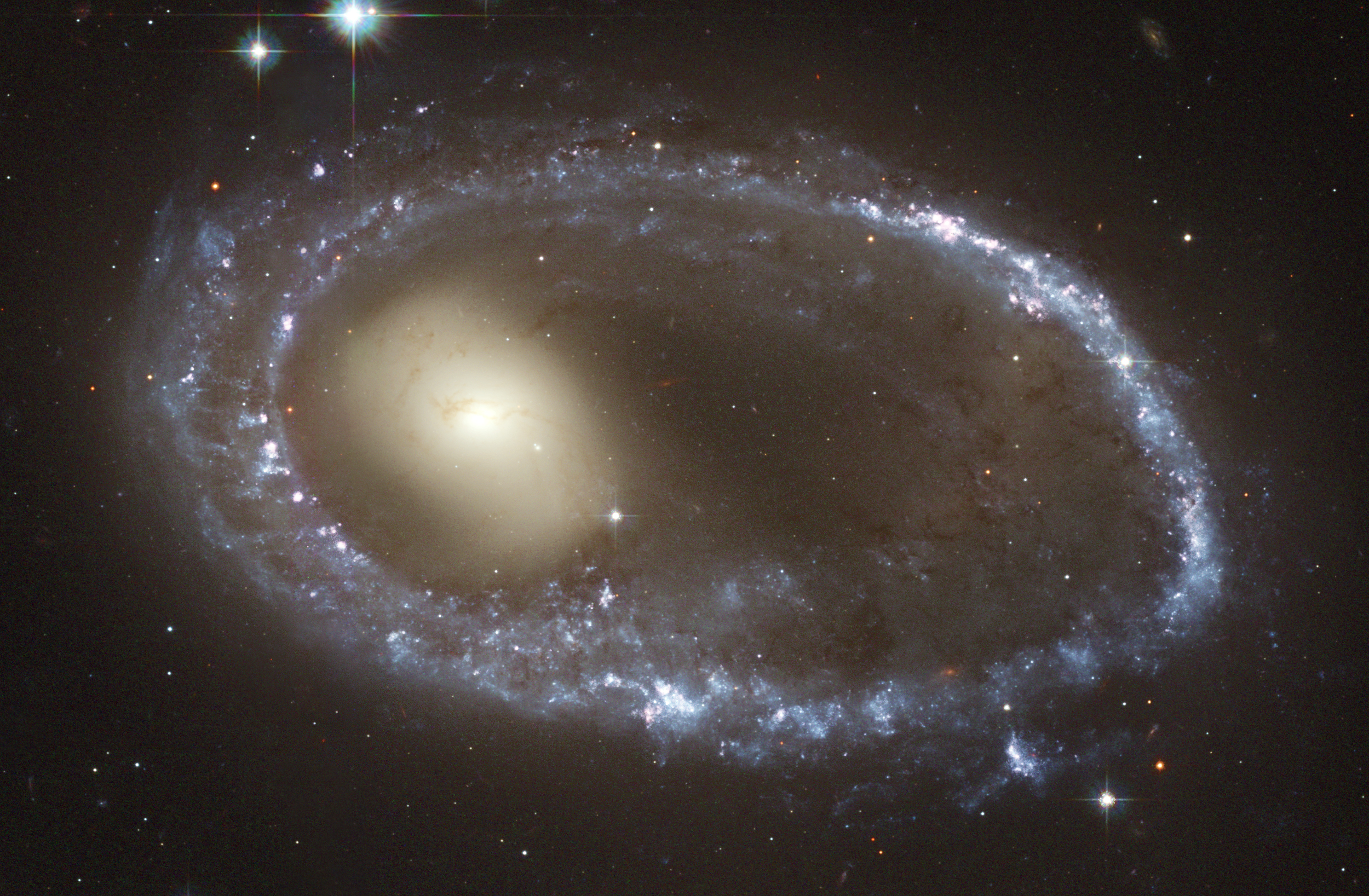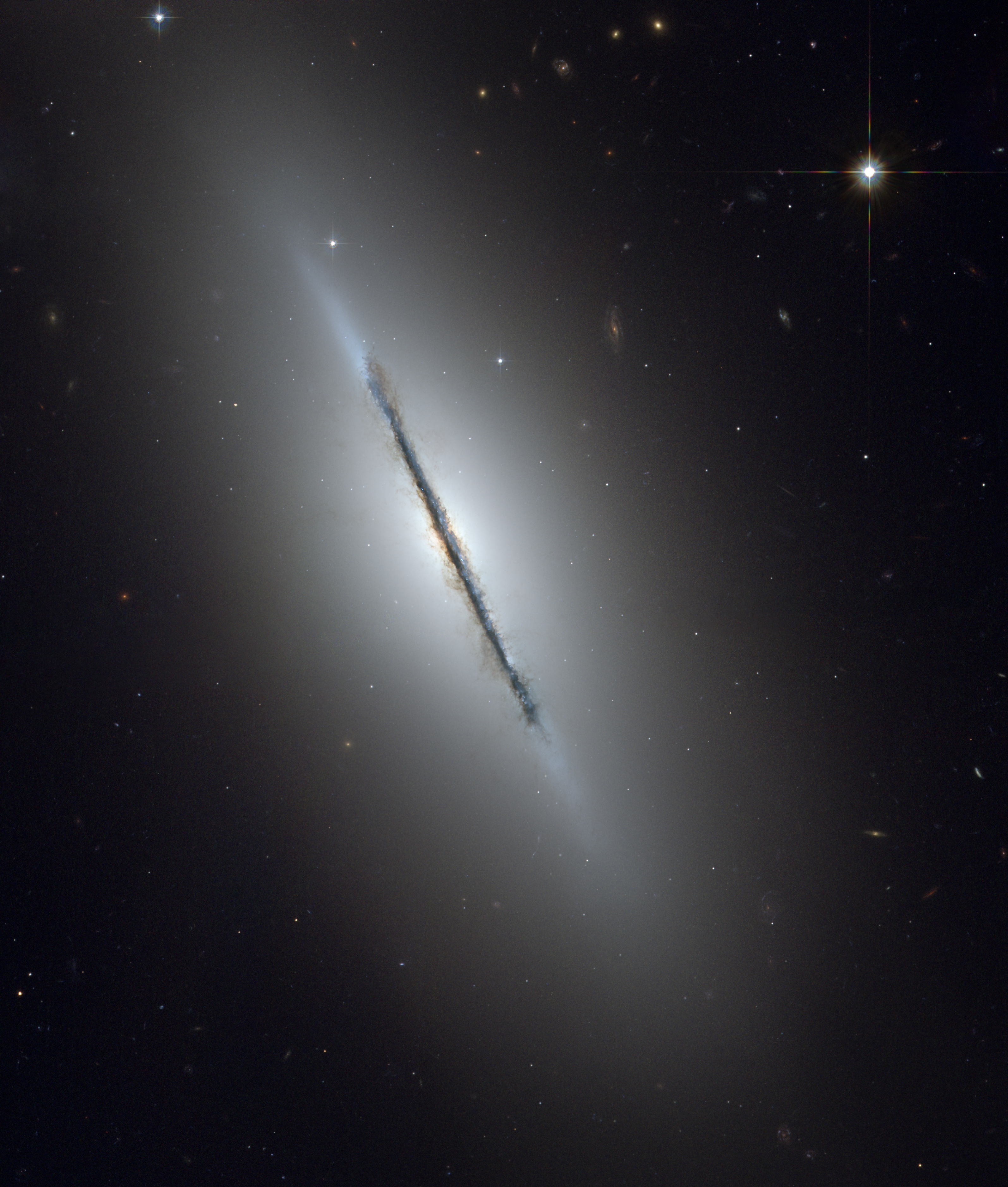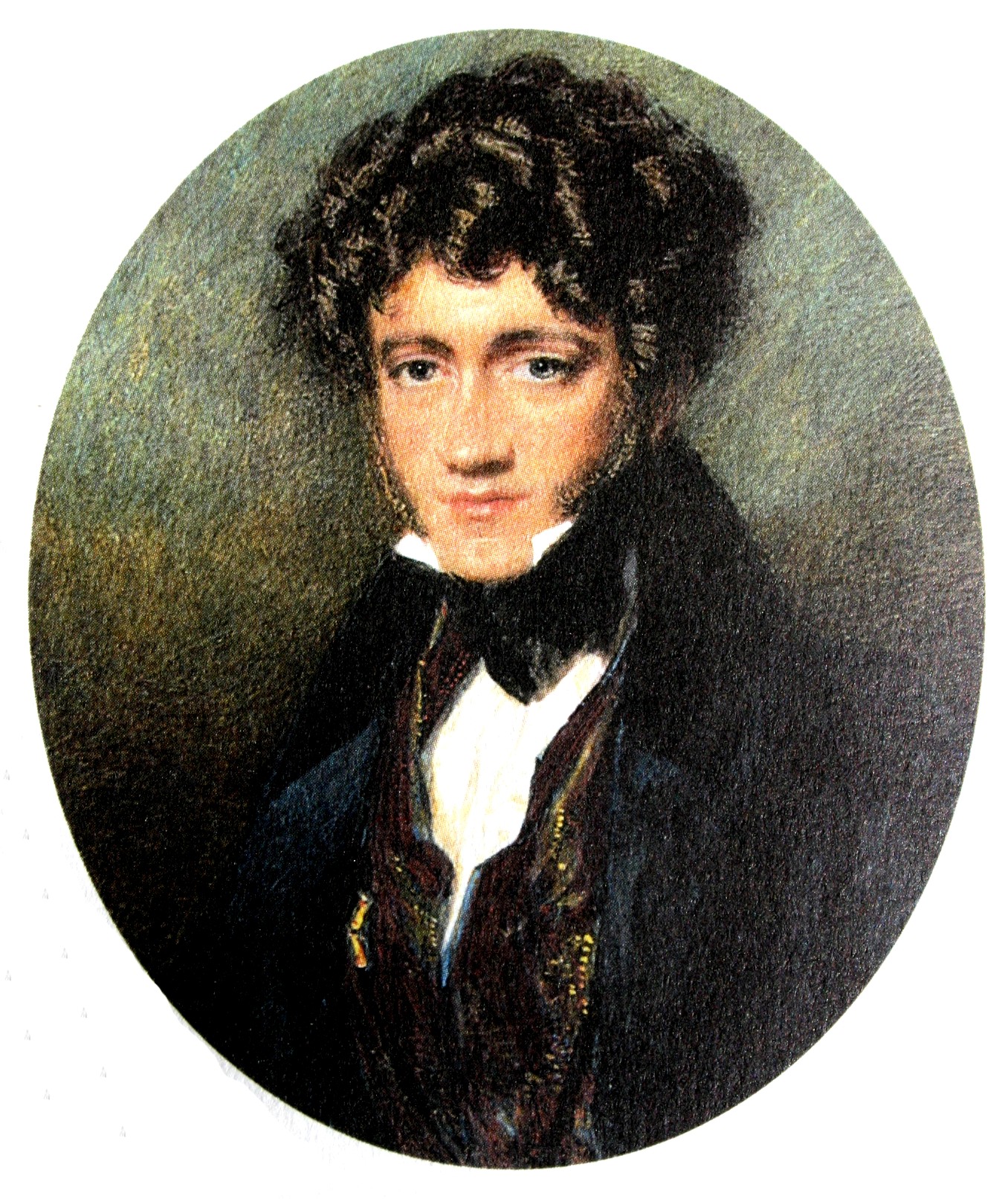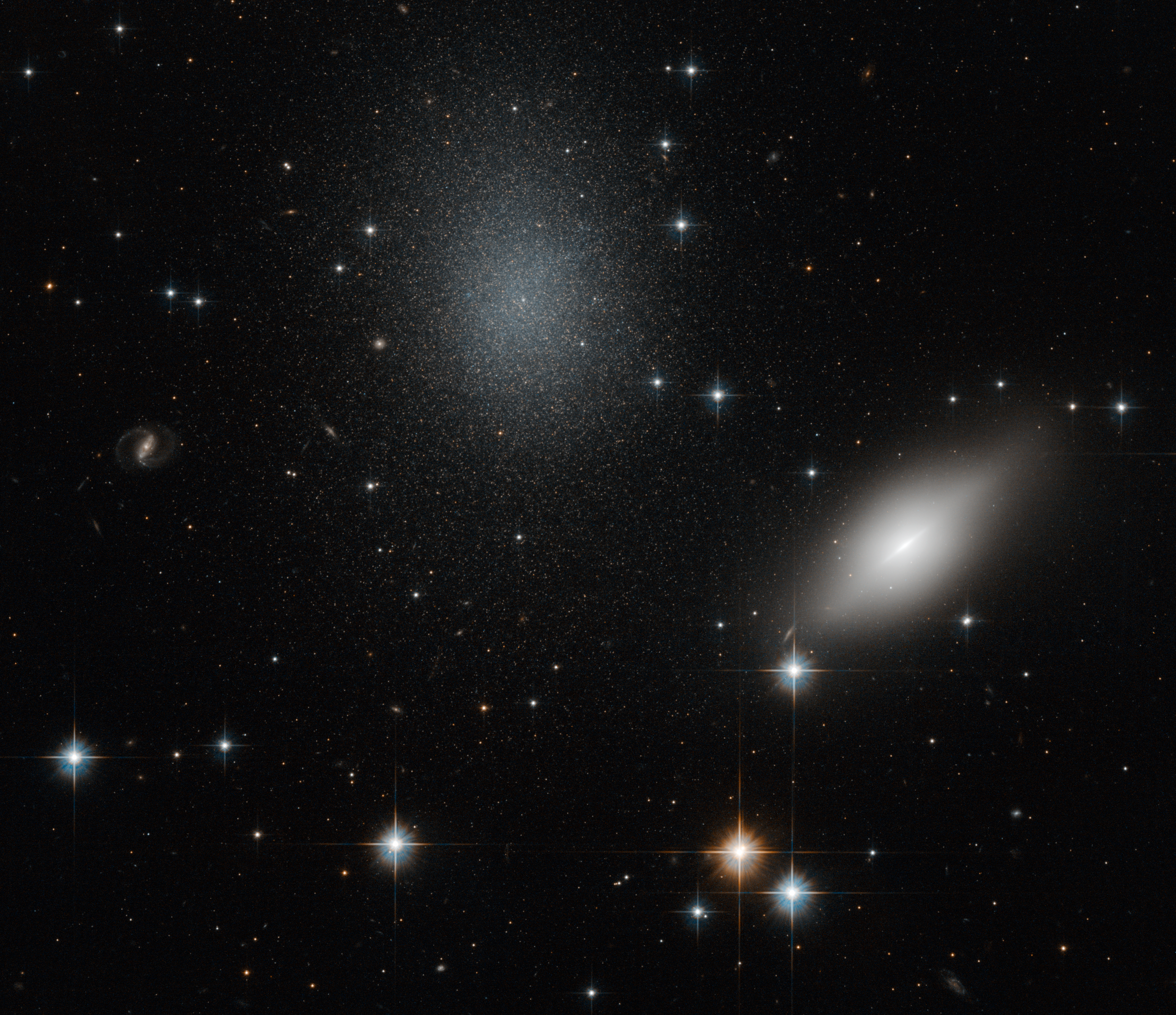|
NGC 5102
NGC 5102, also known as Iota's Ghost since it appears near Iota Centauri in the sky, is a lenticular galaxy in the Centaurus A/M83 Group of galaxies. It was discovered by John Herschel in 1835. Distance measurements At least two techniques have been used to measure the distance to NGC 5102. The surface brightness fluctuations distance measurement technique estimates distances to spiral galaxies based on the graininess of the appearance of their bulges. The distance measured to NGC 5102 using this technique is 13.0 ± 0.8 Mly (4.0 ± 0.2 Mpc). However, NGC 5102 is close enough that the tip of the red giant branch Tip of the red-giant branch (TRGB) is a primary distance indicator used in astronomy. It uses the luminosity of the brightest red-giant-branch stars in a galaxy as a standard candle to gauge the distance to that galaxy. It has been used in conjun ... (TRGB) method may be used to estimate its distance. The estimated distance to NGC 5102 using this technique is 11.1 ... [...More Info...] [...Related Items...] OR: [Wikipedia] [Google] [Baidu] |
New General Catalogue
The ''New General Catalogue of Nebulae and Clusters of Stars'' (abbreviated NGC) is an astronomical catalogue of deep-sky objects compiled by John Louis Emil Dreyer in 1888. The NGC contains 7,840 objects, including galaxy, galaxies, star clusters and emission nebulae. Dreyer published two supplements to the NGC in 1895 and 1908, known as the ''Index Catalogues'' (abbreviated IC), describing a further 5,386 astronomical objects. Thousands of these objects are best known by their NGC or IC numbers, which remain in widespread use. The NGC expanded and consolidated the cataloguing work of William Herschel, William and Caroline Herschel, and John Herschel's ''General Catalogue of Nebulae and Clusters of Stars''. Objects south of the Celestial sphere, celestial equator are catalogued somewhat less thoroughly, but many were included based on observation by John Herschel or James Dunlop. The NGC contained multiple errors, but attempts to eliminate them were made by the ''Revised New Ge ... [...More Info...] [...Related Items...] OR: [Wikipedia] [Google] [Baidu] |
Iota Centauri
Iota Centauri, Latinized from ι Centauri, also named Kulou, is a star in the southern constellation of Centaurus. Based upon parallax measurements, it lies at a distance of approximately from Earth. Iota Centauri has an apparent visual magnitude of +2.73, making it easily visible to the naked eye. The spectrum of ι Centauri matches a stellar classification of A2 V. It is an A-type main sequence star that is generating energy by the nuclear fusion of hydrogen in its core region. This energy is being radiated from the outer envelope of the star at an effective temperature of 9,160 K, giving the star a white hue. It has about 2 times the Sun's mass, 1.9 times the Sun's radius, and is roughly 350 million years old. The abundance of elements other than hydrogen and helium, what astronomers term the metallicity, is only 35% of the abundance in the Sun. A weak magnetic field has been tentatively identified with a strength of . This star has an excess emission of ... [...More Info...] [...Related Items...] OR: [Wikipedia] [Google] [Baidu] |
Unbarred Lenticular Galaxies
An unbarred spiral galaxyAstronomy Pictures(accessed 18 April 2010) is a type of spiral galaxy without a central bar, or one that is not a barred spiral galaxy. It is designated with an SA in the galaxy morphological classification scheme. A nearby example of an unbarred spiral is the Triangulum Galaxy. Barless spiral galaxies are one of three general types of spiral galaxies under the '' de Vaucouleurs system'' classification system, the other two being intermediate spiral galaxy and barred spiral galaxy. Under the ''Hubble tuning fork'', it is one of two general types of spiral galaxy, the other being barred spirals. Grades Unbarred lenticular galaxy An unbarred lenticular galaxy is a lenticular version of an unbarred spiral galaxy. They have the Hubble type of SA0. An example of this is the galaxy AM 0644-741 AM 0644-741, also known as the Lindsay-Shapley Ring, is an unbarred lenticular galaxy, and a ring galaxy, which is 300 million light-years away in th ... [...More Info...] [...Related Items...] OR: [Wikipedia] [Google] [Baidu] |
Lenticular Galaxies
A lenticular galaxy (denoted S0) is a Galaxy morphological classification, type of galaxy intermediate between an elliptical galaxy, elliptical (denoted E) and a spiral galaxy in galaxy morphological classification schemes. It contains a large-scale disc but does not have large-scale spiral arms. Lenticular galaxies are Disc galaxy, disc galaxies that have used up or lost most of their interstellar matter and therefore have very little ongoing star formation. They may, however, retain significant dust in their disks. As a result, they consist mainly of aging stars (like elliptical galaxies). Despite the morphological differences, lenticular and elliptical galaxies share common properties like spectral features and scaling relations. Both can be considered early-type galaxies that are passively evolving, at least in the local part of the Universe. Connecting the E galaxies with the S0 galaxies are the ES galaxies with intermediate-scale discs. Morphology and structure Classific ... [...More Info...] [...Related Items...] OR: [Wikipedia] [Google] [Baidu] |
Tip Of The Red Giant Branch
Tip of the red-giant branch (TRGB) is a primary distance indicator used in astronomy. It uses the luminosity of the brightest red-giant-branch stars in a galaxy as a standard candle to gauge the distance to that galaxy. It has been used in conjunction with observations from the Hubble Space Telescope to determine the relative motions of the Local Cluster of galaxies within the Local Supercluster. Ground-based, 8-meter-class telescopes like the VLT are also able to measure the TRGB distance within reasonable observation times in the local universe. Method The Hertzsprung–Russell diagram (HR diagram) is a plot of stellar luminosity versus surface temperature for a population of stars. During the core hydrogen burning phase of a Sun-like star's lifetime, it will appear on the HR diagram at a position along a diagonal band called the main sequence. When the hydrogen at the core is exhausted, energy will continue to be generated by hydrogen fusion in a shell around the core. The ... [...More Info...] [...Related Items...] OR: [Wikipedia] [Google] [Baidu] |
John Frederick William Herschel
Sir John Frederick William Herschel, 1st Baronet (; 7 March 1792 – 11 May 1871) was an English polymath active as a mathematician, astronomer, chemist, inventor and experimental photographer who invented the blueprint and did botanical work. Herschel originated the use of the Julian day system in astronomy. He named seven moons of Saturn and four moons of Uranus – the seventh planet, discovered by his father Sir William Herschel. He made many contributions to the science of photography, and investigated colour blindness and the chemical power of ultraviolet rays. His ''Preliminary Discourse'' (1831), which advocated an inductive approach to scientific experiment and theory-building, was an important contribution to the philosophy of science. Early life and work on astronomy Herschel was born in Slough, Buckinghamshire, the son of Mary Baldwin and astronomer Sir William Herschel. He was the nephew of astronomer Caroline Herschel. He studied shortly at Eton College a ... [...More Info...] [...Related Items...] OR: [Wikipedia] [Google] [Baidu] |
Centaurus A/M83 Group
The Centaurus A/M83 Group is a complex group of galaxies in the constellations Hydra, Centaurus, and Virgo. The group may be roughly divided into two subgroups. The Cen A Subgroup, at a distance of 11.9 Mly (3.66 Mpc), is centered on Centaurus A, a nearby radio galaxy. The M83 Subgroup, at a distance of 14.9 Mly (4.56 Mpc), is centered on the Messier 83 (M83), a face-on spiral galaxy. This group is sometimes identified as one group and sometimes identified as two groups. Hence, some references will refer to two objects named the ''Centaurus A Group'' and the ''M83 Group''. However, the galaxies around Centaurus A and the galaxies around M83 are physically close to each other, and both subgroups appear not to be moving relative to each other. The Centaurus A/M83 Group is part of the Virgo Supercluster, the local supercluster of which the Local Group is an outlying member. Members Member identification The brightest group members were frequently identified in early ga ... [...More Info...] [...Related Items...] OR: [Wikipedia] [Google] [Baidu] |
Lenticular Galaxy
A lenticular galaxy (denoted S0) is a Galaxy morphological classification, type of galaxy intermediate between an elliptical galaxy, elliptical (denoted E) and a spiral galaxy in galaxy morphological classification schemes. It contains a large-scale disc but does not have large-scale spiral arms. Lenticular galaxies are Disc galaxy, disc galaxies that have used up or lost most of their interstellar matter and therefore have very little ongoing star formation. They may, however, retain significant dust in their disks. As a result, they consist mainly of aging stars (like elliptical galaxies). Despite the morphological differences, lenticular and elliptical galaxies share common properties like spectral features and scaling relations. Both can be considered early-type galaxies that are passively evolving, at least in the local part of the Universe. Connecting the E galaxies with the S0 galaxies are the ES galaxies with intermediate-scale discs. Morphology and structure Classific ... [...More Info...] [...Related Items...] OR: [Wikipedia] [Google] [Baidu] |
Principal Galaxies Catalogue
The Principal Galaxies Catalogue (PGC) is an astronomical catalog published in 1989 that lists B1950 and J2000 equatorial coordinates and cross-identifications for 73,197 galaxies. It is based on the Lyon-Meudon Extragalactic Database (LEDA), which was originally started in 1983. 40,932 coordinates (56%) have standard deviations smaller than . A total of 131,601 names from the 38 most common sources are listed. Available mean data for each object are given: * 49,102 morphological descriptions, * 52,954 apparent major and minor axis, * 67,116 apparent magnitudes, * 20,046 radial velocities and * 24,361 position angles. The Lyon-Meudon Extragalactic Database was eventually expanded into HyperLEDA, a database of a few million galaxies. Galaxies in the original PGC catalogue are numbered with their original PGC number in HyperLEDA. Numbers have also been assigned for the other galaxies, although for those galaxies not in the original PGC catalogue, it is not recommended t ... [...More Info...] [...Related Items...] OR: [Wikipedia] [Google] [Baidu] |
Hubble Space Telescope
The Hubble Space Telescope (HST or Hubble) is a space telescope that was launched into low Earth orbit in 1990 and remains in operation. It was not the Orbiting Solar Observatory, first space telescope, but it is one of the largest and most versatile, renowned as a vital research tool and as a public relations boon for astronomy. The Hubble Space Telescope is named after astronomer Edwin Hubble and is one of NASA's Great Observatories program, Great Observatories. The Space Telescope Science Institute (STScI) selects Hubble's targets and processes the resulting data, while the Goddard Space Flight Center (GSFC) controls the spacecraft. Hubble features a mirror, and its five main instruments observe in the ultraviolet, visible spectrum, visible, and near-infrared regions of the electromagnetic spectrum. Hubble's orbit outside the distortion of atmosphere of Earth, Earth's atmosphere allows it to capture extremely high-resolution images with substantially lower background lig ... [...More Info...] [...Related Items...] OR: [Wikipedia] [Google] [Baidu] |
Centaurus
Centaurus () is a bright constellation in the southern sky. One of the 88 modern constellations by area, largest constellations, Centaurus was included among the 48 constellations listed by the 2nd-century astronomer Ptolemy, and it remains one of the IAU designated constellations, 88 modern constellations. In Greek mythology, Centaurus represents a centaur; a creature that is half human, half horse (another constellation named after a centaur is one from the zodiac: Sagittarius (constellation), Sagittarius). Notable stars include Alpha Centauri, the nearest star system to the Solar System, its neighbour in the sky Beta Centauri, and V766 Centauri, HR 5171, one of the largest stars yet discovered. The constellation also contains Omega Centauri, the brightest globular cluster as visible from Earth and the largest identified in the Milky Way, possibly a remnant of a dwarf galaxy. Notable features Stars Centaurus contains several very bright stars. Its alpha and beta stars are ... [...More Info...] [...Related Items...] OR: [Wikipedia] [Google] [Baidu] |
Second
The second (symbol: s) is a unit of time derived from the division of the day first into 24 hours, then to 60 minutes, and finally to 60 seconds each (24 × 60 × 60 = 86400). The current and formal definition in the International System of Units (SI) is more precise: The second ..is defined by taking the fixed numerical value of the caesium frequency, Δ''ν''Cs, the unperturbed ground-state hyperfine transition frequency of the caesium 133 atom, to be when expressed in the unit Hz, which is equal to s−1. This current definition was adopted in 1967 when it became feasible to define the second based on fundamental properties of nature with caesium clocks. As the speed of Earth's rotation varies and is slowing ever so slightly, a leap second is added at irregular intervals to civil time to keep clocks in sync with Earth's rotation. The definition that is based on of a rotation of the earth is still used by the Universal Time 1 (UT1) system. Etymology "Minute" ... [...More Info...] [...Related Items...] OR: [Wikipedia] [Google] [Baidu] |







